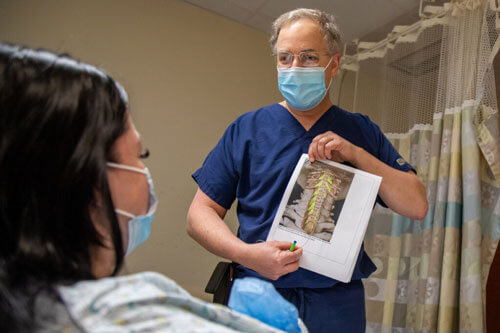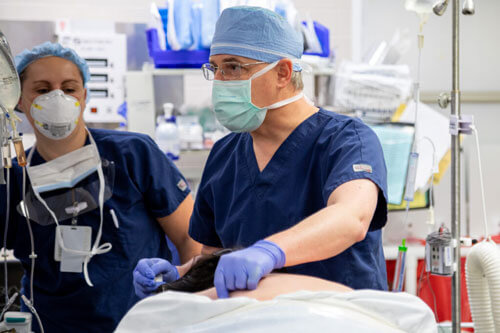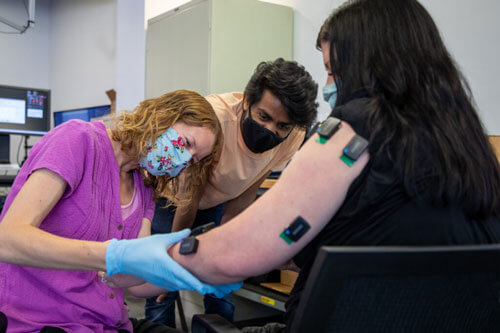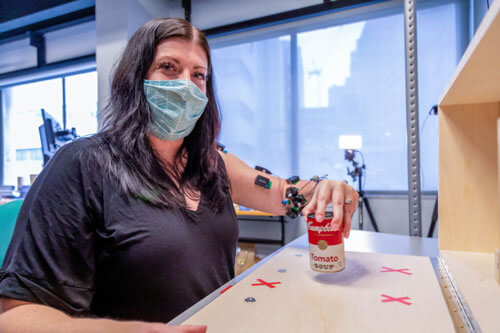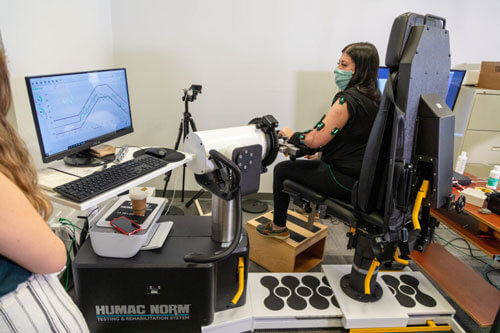STROKE: a Neuro-technology to Return to Using Fork and Knife
Research from the University of Pittsburgh, Carnegie Mellon University and UPMC.
- Metal electrodes on the neck allow patients to regain mobility of the upper limbs and resume their autonomy. The effects persist even without stimulation.
- Stroke can affect 1 in 4 people over the age of 25. 75% may develop lasting upper limb deficits.
- In Italy, stroke is the third leading cause of death after cardiovascular diseases and neoplasms, representing the main cause of disability.
A neuro-technology that stimulates the spinal cord and instantly improves upper limb mobility, allowing stroke patients, both mild and severe, to perform daily activities more easily. This is the result of new research conducted by the University of Pittsburgh, Carnegie Mellon University and UPMC (University Pittsburgh Medical Center) and published today in Nature Medicine, one of the leading British journals specialized in the health field.
The study shows that a pair of thin metal electrodes implanted along the neck allow patients who have suffered damage due to a stroke, to open and close their fist completely, until they can once again use a fork and knife, to raise their arm above their head or to use their hands again. thus regaining the mobility of the upper limbs and peripheral areas and reducing their disability. There are currently no effective treatments to cure paralysis in the so-called "chronic stroke phase", which begins about six months after the event. According to the researchers, the new technology represents an important step forward in improving the daily lives of convalescents.
"We found that electrical stimulation of specific parts of the spinal cord allows patients to regain full mobility. But the real revolution is to have understood that in some cases, after a few weeks of sessions, the improvements remain over time even where no stimulation is performed. This represents a big step forward for science and a real hope for stroke rehabilitation therapies," said correspondent and senior co-author Marco Capogrosso, Ph.D., assistant professor of neurological surgery at Pittsburgh. "Through years of preclinical research, we have developed a practical, easy-to-use stimulation protocol, adapting existing FDA-approved clinical technologies that could be easily reused in the hospital and move quickly from lab to clinic."
Globally, stroke can affect one in four adults over the age of 25, and 75% of these people may develop lasting upper limb deficits, severely limiting their physical autonomy. In Italy, there are about 200,000 cases of stroke every year: 80% are new episodes and 20% are relapses. Although mortality is decreasing, stroke is the third leading cause of death after cardiovascular disease and cancer and is the leading cause of disability. In our country, stroke survivors, with more or less disabling outcomes, are equal to about 913,000. About one year after the acute event, a third of the survivors have a high degree of disability, so as to be totally dependent on the care of others.
"Creating effective neurorehabilitation solutions for people with motor disabilities is becoming increasingly urgent," said co-senior author Elvira Pirondini, Ph.D., assistant professor of physical medicine and rehabilitation at Pittsburgh. "Even mild deficits caused by stroke, in fact, can isolate people and create discomfort in social and professional life, becoming very debilitating, with motor impairments in the arm and hand that prevent simple daily activities, such as writing, eating and dressing".
Spinal cord stimulation consists of using a series of electrodes placed on the surface with the aim of discharging impulses of electricity that immediately activate nerve cells. This technology is already being used to treat chronic pain. In addition, several research groups around the world have shown that this solution can also be used to restore mobility of the lower extremities after a spinal cord injury.
After years of preclinical studies, involving computer models and animal tests with partial arm paralysis, researchers were allowed to test this therapy on humans.
"The sensory nerves in the arm and hand send signals to motor neurons in the spinal cord that control the muscles of the limb," said co-author Douglas Weber, Ph.D., professor of mechanical engineering at the Neuroscience Institute at Carnegie Mellon University. "By stimulating these sensory nerves, we can amplify the activity of muscles weakened by stroke. It is important that the patient maintains full control of their movements: stimulation is assisted and strengthens muscle activation only when patients try to move."
In a series of tests adapted to individual patients, stimulation made it possible to perform tasks of varying complexity, from moving a hollow metal cylinder to gripping common household items and opening a lock. Clinical evaluations have shown that stimulation of cervical nerve roots immediately improves the strength, amplitude of motion and functionality of the arm and hand. The effects of stimulation appear to be longer lasting than scientists had initially thought and persist even after removal of the device, suggesting that it could be used as both a method of assisting and recovering the upper limb. The instantaneous effects of stimulation allow for intense physical training which, in turn, could lead to long-term improvements.
The research reported in this press release was supported by the National Institute of Neurological Disorders and Stroke of the National Institutes of Health under the award number UG3NS123135. The content is the sole responsibility of the authors and does not necessarily represent the official views of the National Institutes of Health. Additional research support was provided by the Department of Neurological Surgery and the Pittsburgh Department of Physical Medicine and Rehabilitation, as well as the Department of Mechanical Engineering and the Neuroscience Institute at Carnegie Mellon University.
